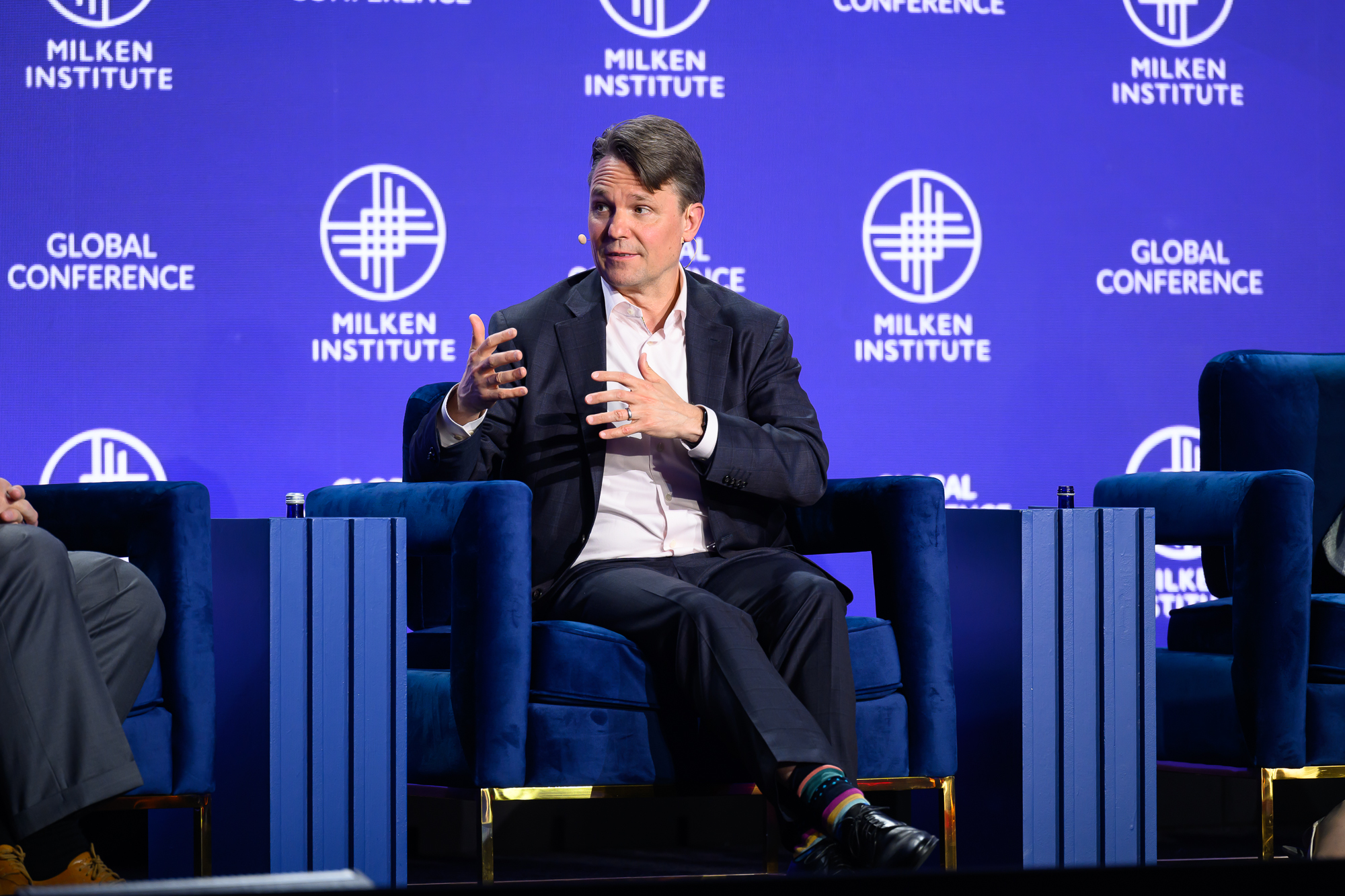Foreword

Jon Webster
Senior Managing Director and Chief Operating Officer
CPP Investments
As organizations confront the rapid evolution of artificial intelligence and automation, the challenges for investors, boards, and management teams are on the rise. At CPP Investments, we are acutely aware that the convergence of AI with talent strategy is a transformative force, one that requires thoughtful consideration and action. This report provides suggestions for how institutional investors might engage with boards and leadership teams to support their efforts to adapt.
The AI-talent nexus is not just an operational issue—for many companies, it’s a strategic imperative. As investors, it’s worth considering questions that go beyond whether AI can boost productivity. We can scrutinize whether the companies we invest in are truly prepared for the workforce transition AI demands. Are they aligning their talent strategies with AI integration? Are they reskilling employees to harness the power of AI, rather than be displaced by it? Failure to answer these questions today may impact long-term returns tomorrow.
This issue is just one of many that investors and boards must consider. Where it ranks alongside other board concerns, including climate change, geopolitics and more, will depend on the specific circumstances of each company and its sector.
As investors, we’re working through the early uncertainties of this technological transition with equal parts humility and resolve. As we do, we see much value in sharing our experiences and evolving views. We hope this report equips you with some initial tools to challenge the status quo and help drive meaningful, future-proof strategies across your portfolio.
We offer it as a starting point in what we hope will be a meaningful exchange of ideas across the investing ecosystem.
Introduction: Navigating the AI-talent Nexus
Automation and artificial intelligence have the potential to dramatically boost workforce productivity, creating exciting opportunities for companies and investors.1 But capturing those opportunities—and the returns they generate—will demand a careful approach to governance, particularly in relation to AI and talent strategy.
This “AI-talent nexus” is in one sense just the latest 21st century business opportunity and risk to confront investors, boards and management. As such, it will need to be balanced against myriad other demands related to cybersecurity, geopolitics, climate change and more.
Yet the significant possibilities and risks surrounding AI and automation, along with the rapid pace of their adoption, make their intersection with talent strategy an important topic for investor discussion.
Generative AI, along with other automation tools such as traditional machine learning and robotics, has the potential to free up as much as 70% of employees’ time.2 However, human involvement remains essential, particularly in business situations where value rests in asking the right questions, understanding context, and navigating novel and evolving challenges.3
To seize the opportunities brought by these technologies, boards and management need to ensure talent and AI strategies are seamlessly integrated—and designed to both harness AI’s potential and empower workers to create greater value.
For long-term investors, especially those with a broad range of holdings, the challenge will be to understand how best to balance AI-driven innovation with workforce transformation—and to set clear expectations that the directors they appoint do the same.
“A failure to determine whether portfolio companies are appropriately considering this new AI-talent nexus could pose risks to future investment returns,” said Richard Manley, Chief Sustainability Officer at CPP Investments. “Conversely, those companies pursuing an integrated AI-talent strategy may outperform those focused on technology deployment alone.”
Despite its potential, AI presents significant challenges. Boards and management need to carefully navigate the workforce impacts of AI, such as potential job displacement and the need for new skills.
Moreover, much remains unknown about the exact course this technology will take and how it will be put to work.
By engaging proactively with directors and management of portfolio companies (“portcos”), investors can both appraise director oversight of this issue and inform their own investment processes. They can help guide boards and management through the AI-talent nexus by setting clear expectations, ensuring boards are equipped with the right expertise, upskilling their workers, and tracking key performance indicators (KPIs) for AI adoption and workforce integration. By fostering collaboration between portcos, investors, and regulatory bodies, stakeholders can work together to build sustainable AI strategies that drive long-term value creation and workforce resilience.
This paper presents key questions to guide boards and management in integrating AI and talent strategies in public and private companies. Based on CPP Investments’ own global expertise and early lessons learned through its engagement with private portcos, they reflect the concerns and high expectations of an institutional investor.4 These questions are by no means exhaustive but are meant to drive further sharing and ongoing collaboration among peers and partners that will benefit the investing ecosystem as a whole.
AI’s impact is likely to be profound, but uneven. Generative AI is expected to have the greatest impact on the knowledge workforce (including business and legal professionals, office support, and customer service), while traditional automation will primarily affect predictable physical work.5
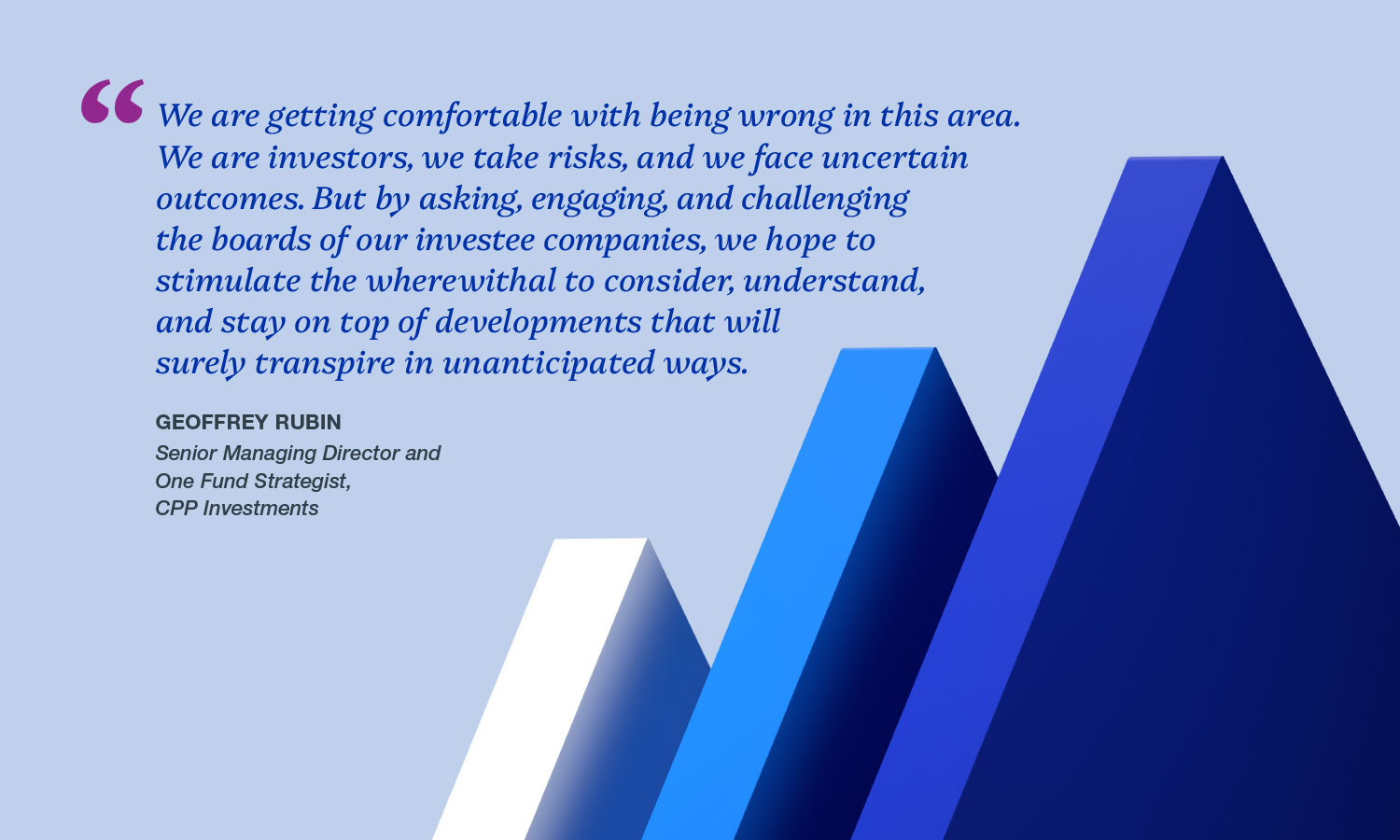
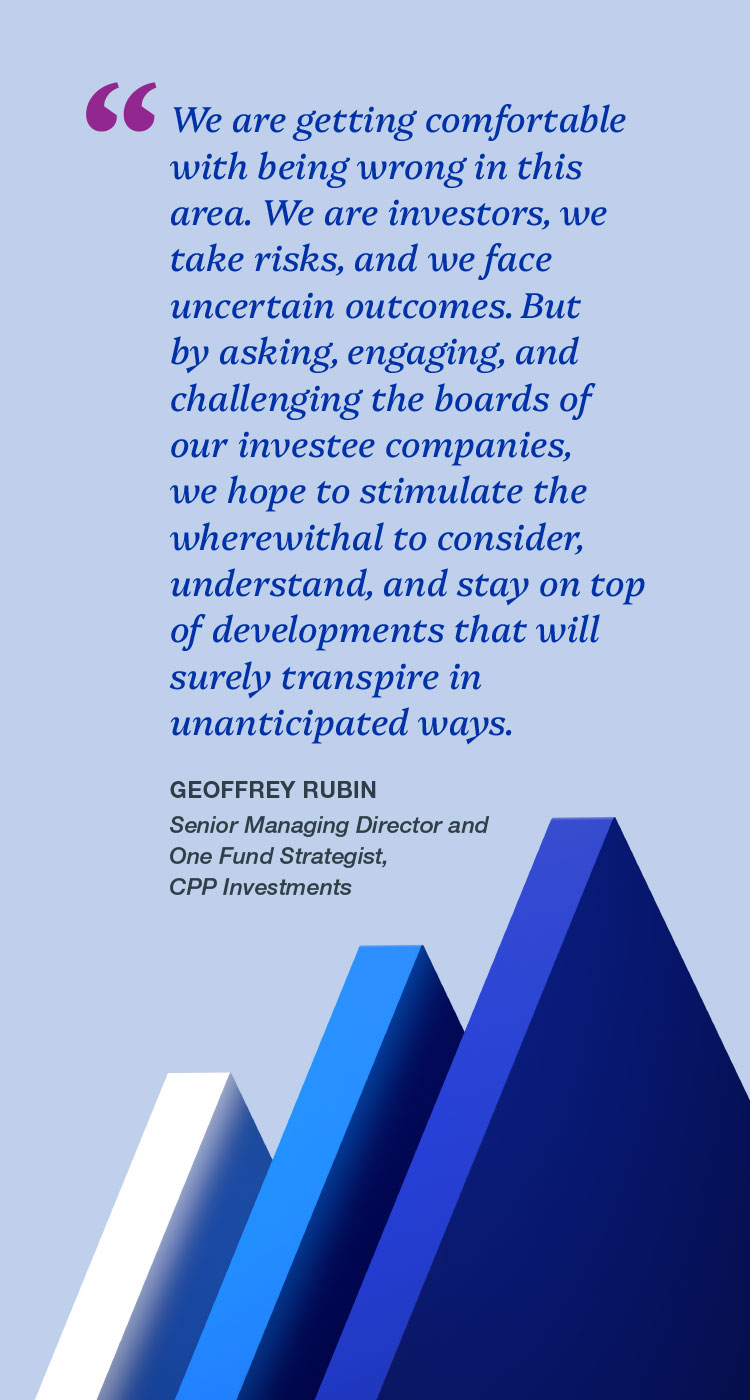
No one-size-fits-all approach exists—investors must encourage boards to tailor AI strategies to their specific industries, ensuring directors are equipped with the necessary expertise to oversee these shifts.
CPP Investments has started working with boards on steps to integrate AI oversight into governance and to align talent strategies with technological advancements. It aims to hold the boards of its portcos to account for overseeing management teams and ensuring appropriate upskilling efforts and measurable KPIs are in place. As AI’s impact on the workforce evolves, investors must ensure boards are not simply reacting, but are leading and managing this issue in a manner aligned with the pace of change and AI exposure in their specific sectors.
The questions provided here are rooted in established governance principles and tailored to AI’s specific challenges. Like the technology itself, they will evolve, and ongoing engagement within the investing ecosystem will be critical as peers and partners develop their own questions to supplement them.
Nevertheless, they represent an essential starting point for investors to ensure boards are actively managing the intersection of AI and human capital.
AI + Talent: Integrating Strategies
Current versions of AI and automation are far from the first technologies to change established ways of working. From tractors to robot-enabled assembly lines, technological innovation has always played a role in enhancing labour productivity. What distinguishes today’s technologies are their scale, and in the case of generative AI, its potential to displace knowledge workers. While prior innovations amplified human motor or computational skills, AI is increasingly performing more complex cognitive tasks.
Yet generative AI also holds the exciting potential to expand human capabilities. Research from the BCG Henderson Institute suggests generative AI can not only boost worker efficiency on certain tasks, but also broaden the range of tasks workers can perform.6 What’s more, AI’s potential to elevate the productivity of an organization’s most senior, highest paid employees could lead to considerable payoffs for firms. These factors should be top of mind for companies tailoring a talent strategy to the AI era.
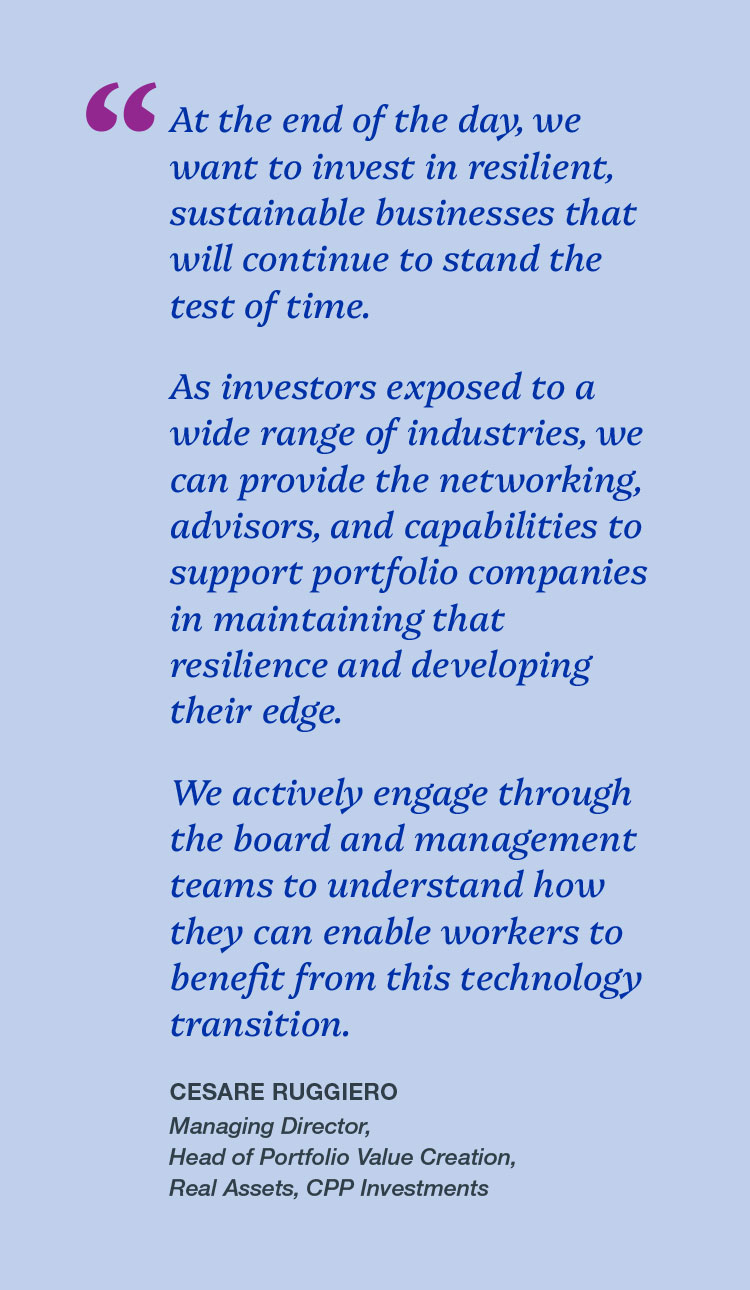 Investors must assess how boards and management are evaluating automation and AI’s transformational impact on staffing levels, skill sets, and worker retention. Hiring strategies may need to adapt while opportunities and risks related to retraining/reskilling will need a greater degree of attention—particularly when it comes to preparing workers to deploy AI productively and responsibly.
Investors must assess how boards and management are evaluating automation and AI’s transformational impact on staffing levels, skill sets, and worker retention. Hiring strategies may need to adapt while opportunities and risks related to retraining/reskilling will need a greater degree of attention—particularly when it comes to preparing workers to deploy AI productively and responsibly.
Indeed, the more AI is integrated into the real economy, the more integral training will become to a company’s ability to compete. “The war is no longer for talent,” said Jeff Schwartz, Vice President of Insights and Impact at Gloat. “The war is to develop talent. And that’s an internal front.”
An integrated talent and AI strategy cannot be made in a vacuum of the company’s own operations and objectives. Companies’ use of AI will be affected by a range of factors including (but not limited to) capital costs, evolving regulations, and environmental costs related to emissions, water consumption, and more. And the nature and extent of any engagement strategy will first need to be determined by a materiality assessment—that is, by identifying the relative importance of these technologies to the organization.
Boards and management teams must closely monitor how their competitors’ AI usage will affect pricing, product development, customer experience, environmental costs, and all other factors that ultimately drive margins and growth. Similarly, investors need to ensure portcos are balancing these many considerations by engaging with boards and management teams. In addition, they’ll need to ensure workforce strategies are flexible enough to adapt to rapid advancements in AI capability and consumer expectations—while being mindful of the regulatory and stakeholder impact of shifts in labour supply and demand.
Collaboration with the broader ecosystem of partners can help companies stay on top of trends. For instance, the AI-Enabled ICT Workforce Consortium led by Cisco and joined by Accenture, Eightfold, Google, IBM, Indeed, Intel, Microsoft, and SAP assessed AI’s impact on technology jobs and identified skills development pathways for the roles most likely to be affected by the technology.7
But first, preserving the long-term value of an organization requires conscientious oversight. This begins at the top of the funnel, with clear expectations set by the financial sponsor and by the company’s board of directors. Soon after the launch of ChatGPT in 2022, CPP Investments revised its expectations of boards to state that where companies deploy AI, it expects the company board to provide the appropriate oversight and counsel to the executive team.8 This oversight and counsel should seek to ensure the executive team proactively mitigates the risk of this technology (including where material, the nexus to labour), while pursuing the opportunities it presents. This is consistent with its duty to ensure all material risks and opportunities are considered when setting and implementing strategy and communicating with the market.
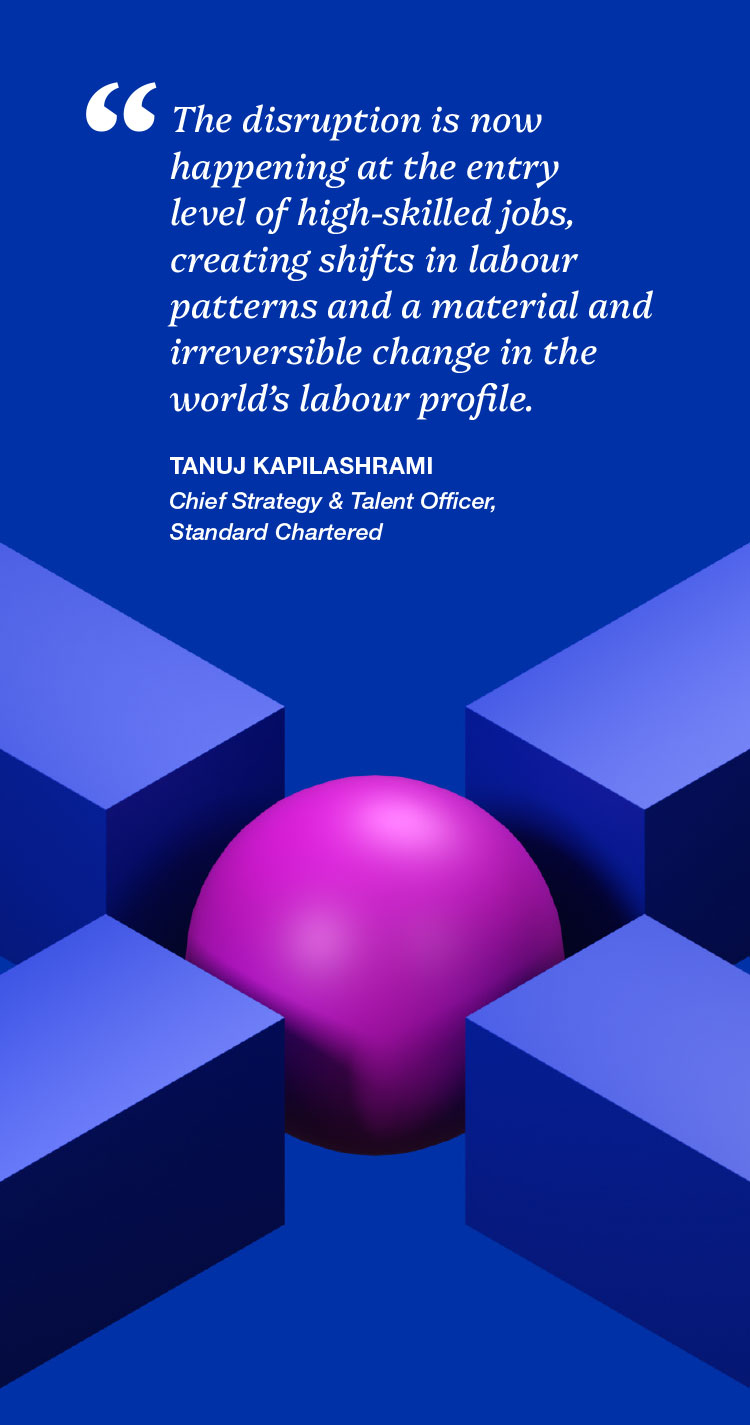 Broad oversight of AI as a component of strategy
Broad oversight of AI as a component of strategy
- How is AI integrated into the company’s core strategy, and how is it being leveraged to enhance competitive advantage and drive measurable long-term value across the business?
- Has the company identified where the biggest opportunity for AI deployment rests within its workforce? Has it made a plan to seize that opportunity?
- How does the board ensure adequate oversight of AI and talent integration, what specific KPIs have been adopted to track success and does the current governance structure allow for sufficient depth of review?
Nesting talent strategy into AI strategy
- How is the company benchmarking its AI and talent strategies against competitors, and what concrete steps are being taken to address risks and drive competitive advantage?
- What mechanisms are in place to assess and address skills gaps related to AI deployment, and how is the company balancing internal talent development with external hiring to align with long-term business needs?
Worker retention and adoption
- What incentive structures and retention strategies are in place to ensure AI adoption and workforce redeployment, and how is success being measured?
- Has the company identified the employee value proposition for early adopters beyond incentive structures?
- What programs are in place to foster upskilling and continuous learning, and how is the company ensuring employees build foundational and strategic skills as AI automates routine tasks?
- Is the company getting AI into the hands of its early adopters / beta testers, as well as those employees in a position to create value with it?
- What measurable outcomes demonstrate that AI is enhancing human performance and productivity, and how are these improvements being tracked?
Data collection, sharing and management
- How does the company’s data governance framework ensure compliance, security, and effective collaboration, and what oversight mechanisms are in place to monitor data sharing practices and manage risks?
Addressing Governance
Across many industries, boards are already actively discussing AI and are willing to engage with investors to consider its impact. This eagerness reflects a general perception among boards that AI could represent an inflection point in corporate productivity and a generational opportunity to transform everything from how companies answer customer questions to how they create code and prepare financial reports.
Boards will increasingly need to decide whether AI will have an asymmetrically favourable return-to-risk profile. They’ll have to determine whether automation and AI’s potential to enhance productivity and margins outweighs its risks. And they’ll need to consider which questions are most appropriate to ask as they constructively challenge management teams assessing and pursuing AI opportunities that benefit their business, customers, and employees.
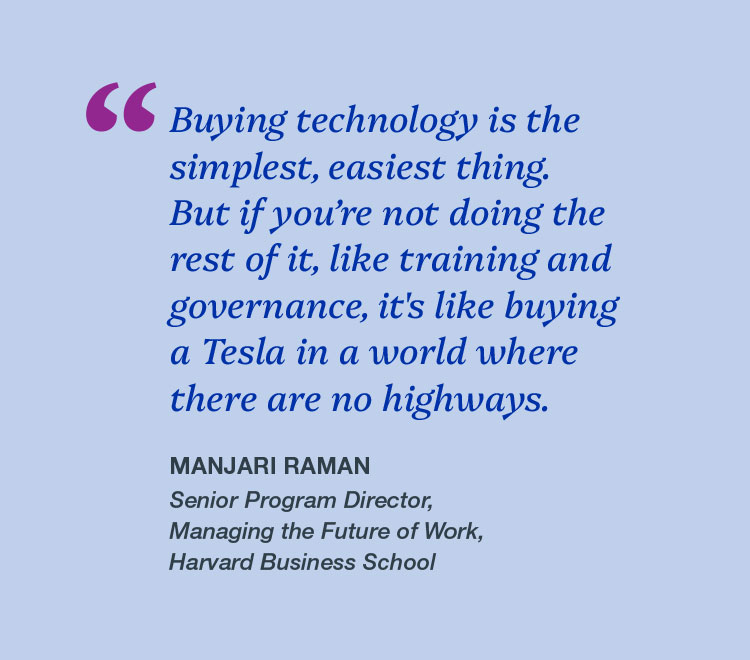 To be sure, AI does present tremendous opportunities for some business models—but it also introduces potential risk. Previous papers have touched on the need for strong board oversight of the responsible deployment of AI to mitigate unintended consequences such as intellectual property theft and bias.9 Here, we explore the importance of board oversight in ensuring AI is deployed to minimize risks related to talent, while optimizing the business’ mix of human and digital capital.
To be sure, AI does present tremendous opportunities for some business models—but it also introduces potential risk. Previous papers have touched on the need for strong board oversight of the responsible deployment of AI to mitigate unintended consequences such as intellectual property theft and bias.9 Here, we explore the importance of board oversight in ensuring AI is deployed to minimize risks related to talent, while optimizing the business’ mix of human and digital capital.
Investors will need to ensure portcos’ boards are taking a holistic view that includes automation and AI’s workforce impact and are equipped to provide effective oversight and guidance to management. That means ensuring the necessary governance structures are in place within portcos to oversee strategic decisions related to automation and AI. Given the highly complex and rapidly evolving nature of these technologies, investors should determine whether a board possesses—or has access to—the expertise and tools needed to evaluate risks and opportunities.
Board composition & training
- Does the board have the necessary expertise or access to external resources to stay informed on AI, machine learning, and automation, and to provide informed challenge and counsel on AI-talent strategy?
- How is the board ensuring it remains equipped to assess whether management’s AI strategy mitigates risks and maximizes potential?
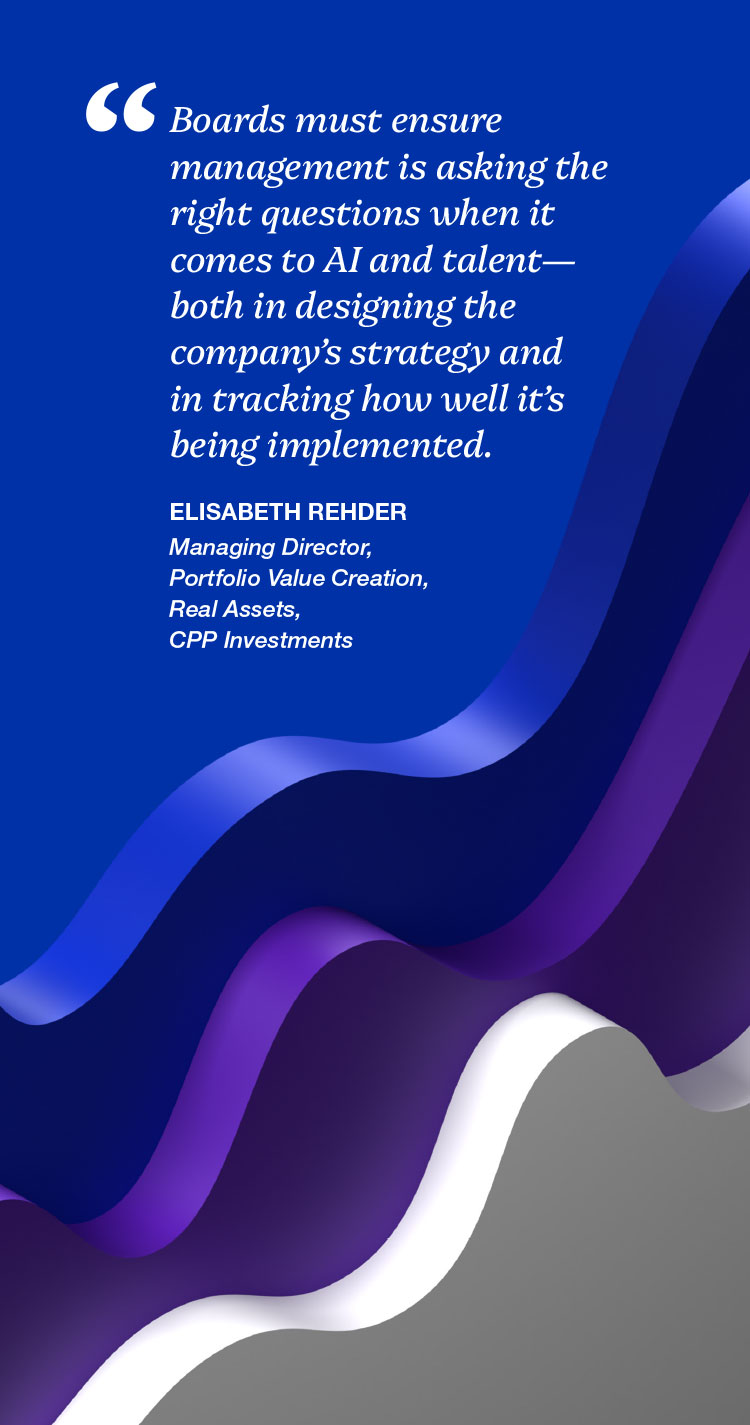
- Has the board been provided, and does it continue to seek, ongoing training or external advice on AI risks and opportunities, especially as they pertain to talent?
Engagement with management
- Has AI been considered in the company’s materiality assessment / risk matrix? If so, where did it fall and how has the company responded?
- How is the board ensuring that AI initiatives are aligned with the company’s broader strategic priorities, and that foundational aspects such as infrastructure, security, and talent readiness are in place before advancing to more complex applications?
- How are AI risks assessed across departments, and are clear lines of accountability established at the C-level?
Responsible deployment
- Is the company treating the responsible deployment of AI as a strategic imperative for management and the workforce?
- What policies has the company enacted to ensure AI is deployed in ways that strengthen trust among employees, customers, communities, and other stakeholders, and how are these policies regularly reviewed and updated?
Monitoring the Transition
As the deployment of AI expands, investors will need to track their portfolios’ aggregate exposure to the potentially transformational impact of this technology, including its integration with talent strategy. This requires KPIs that measure how effectively a company harnesses AI’s potential and uses it to drive long-term shareholder value. Given the speed at which AI is being developed, many of these metrics either don’t exist yet or aren’t consistently reported. For instance, this year, 9 out of 10 global executives said they plan to either increase or keep steady their investment in learning and development, including upskilling and reskilling. Yet only 4% measure and assess the results of these efforts.10
Investors should actively engage with boards to understand which performance metrics are most useful to decision making and therefore critical for directors and investors to monitor as they assess a company’s AI strategy. They should challenge whether companies have appropriate targets for their AI and automation initiatives—and ensure boards are holding management teams accountable for reaching them.
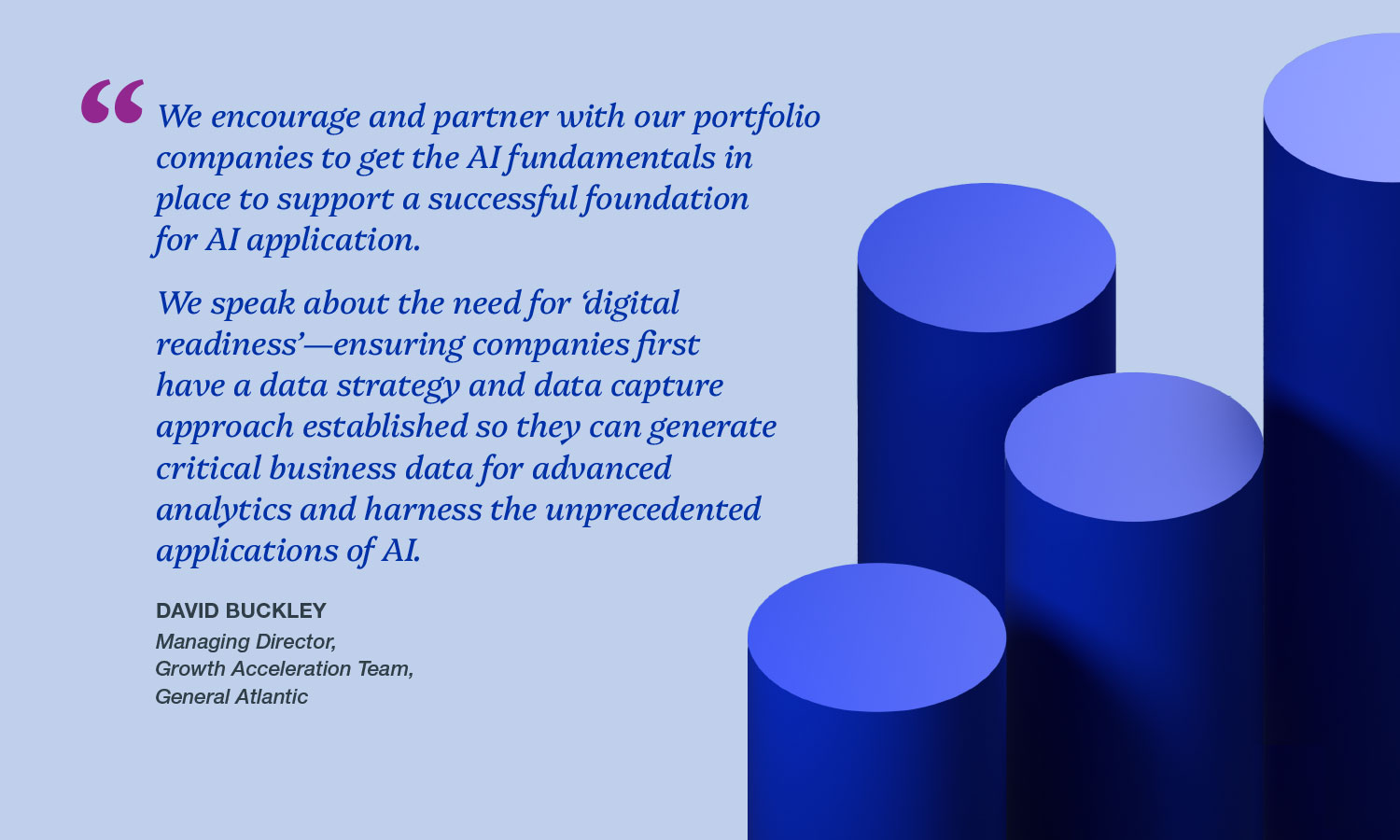
Measuring impact
- What specific KPIs has the company identified to measure the impact of integrating AI with talent strategy on financial performance, employee productivity, and long-term value creation?
- What specific metrics are used to assess whether efficiency and quality improvements are sustained when AI use cases are scaled, and how does the company ensure scalability without compromising outcomes?
- What metrics are used to track the success of the company’s data management strategy in ensuring compliance with legal regulations (e.g., GDPR) and maintaining cybersecurity, and how are these metrics regularly updated?
Mapping skills gaps
- Has the company conducted a thorough mapping of current and future workforce needs?
- How regularly does the company update this mapping and its talent strategy in response to technological advancements? Who is responsible for this monitoring?
Tracking adoption
- What metrics and tools (e.g., surveys, KPIs) are being used to track the impact of upskilling initiatives, the adoption of AI tools, and employee satisfaction, and how frequently are these insights reviewed by management and the board?
- What specific tools (e.g., surveys, feedback mechanisms) are being used to track employee satisfaction during the transition to AI and automation, and how frequently are these insights reviewed by management and the board?
As the deployment of AI expands, investors will need to track their portfolios’ aggregate exposure to the potentially transformational impact of this technology, including its integration with talent strategy. This requires key performance indicators (KPIs) that measure how effectively a company harnesses AI’s potential and uses it to drive long-term shareholder value. Given the speed at which AI is being developed, many of these metrics either don’t exist yet or aren’t consistently reported. For instance, this year, 9 out of 10 global executives said they plan to either increase or keep steady their investment in learning and development, including upskilling and reskilling. Yet only 4% measure and assess the results of these efforts.10
Investors should actively engage with boards to understand which performance metrics are most useful to decision making and therefore critical for directors and investors to monitor as they assess a company’s AI strategy. They should challenge whether companies have appropriate targets for their AI and automation initiatives—and ensure boards are holding management teams accountable for reaching them.
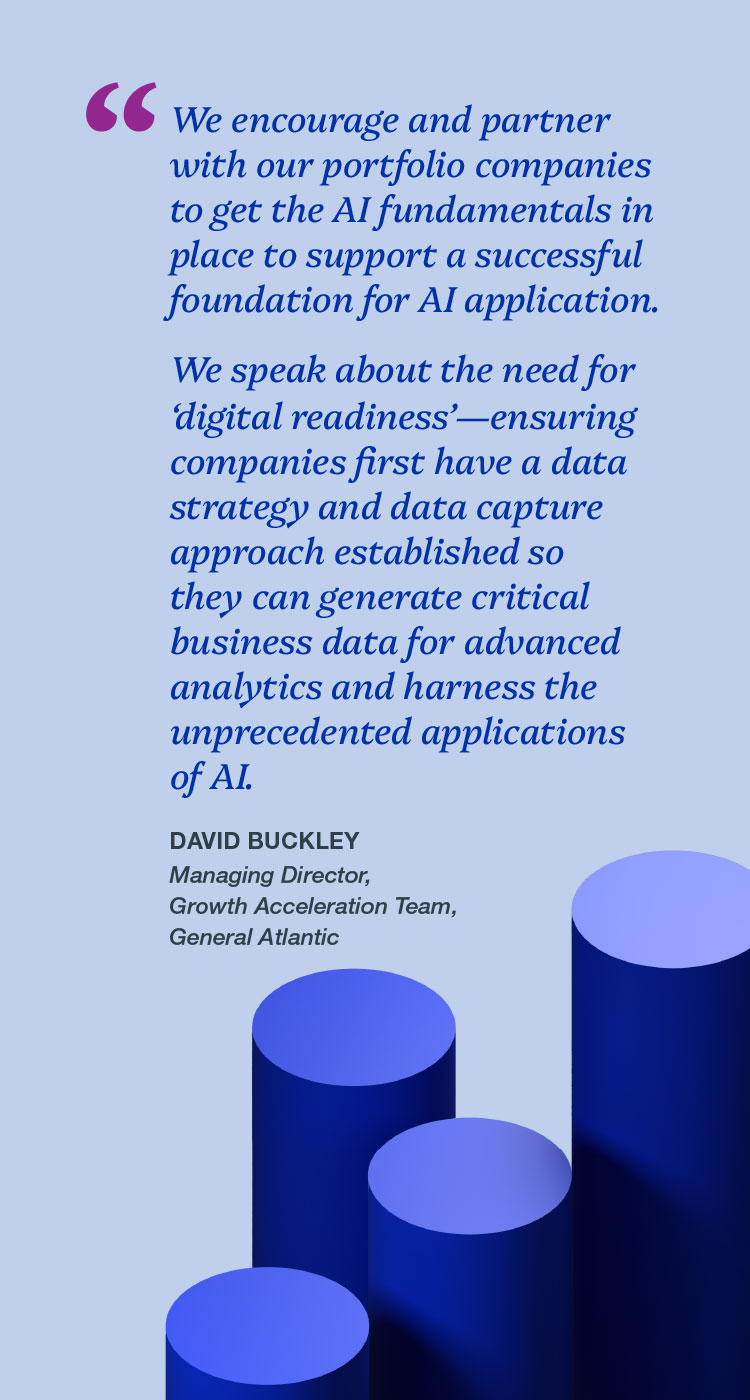
Measuring impact
- What specific KPIs has the company identified to measure the impact of integrating AI with talent strategy on financial performance, employee productivity, and long-term value creation?
- What specific metrics are used to assess whether efficiency and quality improvements are sustained when AI use cases are scaled, and how does the company ensure scalability without compromising outcomes?
- What metrics are used to track the success of the company’s data management strategy in ensuring compliance with legal regulations (e.g., GDPR) and maintaining cybersecurity, and how are these metrics regularly updated?
Mapping skills gaps
- Has the company conducted a thorough mapping of current and future workforce needs?
- How regularly does the company update this mapping and its talent strategy in response to technological advancements? Who is responsible for this monitoring?
Tracking adoption
- What metrics and tools (e.g., surveys, KPIs) are being used to track the impact of upskilling initiatives, the adoption of AI tools, and employee satisfaction, and how frequently are these insights reviewed by management and the board?
- What specific tools (e.g., surveys, feedback mechanisms) are being used to track employee satisfaction during the transition to AI and automation, and how frequently are these insights reviewed by management and the board?
Conclusion
AI and automation have the potential to affect companies and their workforces on a massive scale, creating opportunities to drive value, but also introducing new types of risks.
Boards are ultimately accountable for overseeing the management teams tasked with building and executing tailored strategies for their companies and employees. As AI and automation continue to evolve at pace, prudent investors also have a role to play in engaging portcos in constructive dialogue.
The broad industry perspective of large institutional investors enables them to offer valuable insights, share best practices and identify third-party resources to support portcos as they manage workforce transitions. This includes providing guidance on how AI is reshaping customer expectations and pointing portcos to qualified organizations that specialize in training on digital skills.
As AI becomes a more important part of business operations, so too will collaborative discussions focused on sustainable solutions that drive growth and prosperity.
Case Study 1
Standard Chartered: Mapping skills for an AI-driven economy
Resilience, critical thinking—and an ability to manage ambiguity.
As automation and AI transform the workplace, these “human skills” will become just as critical as technical ones, said Tanuj Kapilashrami, Chief Strategy & Talent Officer at Standard Chartered, a global bank with operations in over 50 markets.
“I call them ‘enabling skills,’ because they’re what we’ll need to enable this transition,” Kapilashrami said. “I genuinely believe automation and AI will increase productivity. But I also believe these enabling skills will be critical to helping people deliver what technology and machines cannot.”
In 2020, Standard Chartered conducted an extensive firm-wide evaluation to determine which skills and jobs would be essential to the bank’s operations over the next three, five and 10 years. It has refreshed the analysis regularly, including after ChatGPT thrust generative AI into the mainstream. The bank’s analysis found that a significant level of disruption to existing jobs was likely. While many roles would disappear, a large proportion of new roles, including those focused on AI governance, prompt engineering, and ethics were likely to emerge. And even as technical skills like data analysis, visualization and cybersecurity became critical to the bank, so too would creative thinking and other human capabilities.
A subsequent analysis from a gender perspective found that a disproportionate amount of job disruption would impact female staff. Training and reskilling needed to be a priority.
“It became very clear that if we didn’t take action around upskilling, reskilling, and redeployment, the proportion of women in our workforce would reduce” Kapilashrami said.
Having identified its skills gaps, the bank set out to bridge them through a multi-year plan to build a future-ready workforce. Specifically:
- In 2020, it established future skills academies to provide learning and development opportunities for employees in both technical and human skills.
- It established an AI-backed platform to curate content and scale learning opportunities.
- It deployed an AI-enabled “Talent Marketplace” to match the demand and supply of skills within the organization, and to give employees an opportunity to work on projects aligned with their interests. A risk analyst in Bangalore, for instance, may have skills needed to help with a project to develop green bonds. “They give a few hours of time a week and learn that way,” Kapilashrami said.
The bank has now turned its attention to mapping “skills adjacencies”, or linkages between the skills employees currently have and those that will be needed in the future. The work involves deconstructing traditional “job families”—for example in corporate banking—into their component skills. In addition, learning councils have been set up in collaboration with senior executives from each line of business to fine-tune learning to their specific functions.
The work has demanded a major cultural shift toward continuous learning inside the organization, Kapilashrami said.
“But from an employee perspective it is increasing satisfaction. Engagement scores are high. People believe the company is investing in their career development and growth.”
Case Study 2
CPP Investments: Making AI governance, education and skills a priority
CPP Investments strives to be on the forefront of identifying how regulatory, political, social, and other changes can affect both its own operations and those of the companies in which it invests. It seeks to apply this thinking to advances in AI through its approaches to:
Governance
CPP Investments endeavours to ensure portcos are leveraging AI to the greatest extent possible while avoiding risk. Given its extensive portfolio, it is also exploring the opportunities to disseminate its learnings from these efforts across the organization.
- CPP Investments redrafted its policy on sustainable investing to identify the deployment of artificial intelligence as a material sustainability factor, spelling out the expectation of boards to provide oversight of this emerging business risk and opportunity.11
- This put CPP Investments among the first institutional investors globally to make this identification.
- CPP Investments has a specific approach related to how it constitutes boards, recruits directors and sets expectations for portco boards. As an identified sustainability factor, AI is now among the priorities identified for those boards.
Portfolio companies
CPP Investments’ Portfolio Value Creation (PVC) team seeks to drive value as it relates to AI across our global portfolio of material direct equity investments by:
- Identifying where the AI-talent nexus is material to individual business strategy.
- Actively evaluating how to incorporate responsible AI considerations into its ongoing approach to governance. This approach includes addressing relevant social, environmental and governance matters in a disciplined way and includes how it provides support to management teams navigating risks and opportunities.
- Leveraging the expertise of its in-house data science and engineering team to support portcos as they develop and execute AI strategies aligned to business value. This includes offering guidance on the enabling technologies and talent capabilities required for success.
- Partnering with investors and other subject matter experts to ensure the implications and risks associated with AI inform investment cases and help shape asset management priorities, which can include talent priorities at the senior executive level.
- Maintaining a robust process for reviewing and approving the appointment of directors to portco boards. This includes understanding board requirements as they relate to AI and conducting board composition matrixing for each of its portco on the private side to identify and remedy skills gaps.
- Prioritizing ongoing investor education, CPP Investments hosts an annual Directors Day, bringing together non-executive directors from across its portfolio. This event encourages them to share insights and learn about the latest trends and topics, helping them to become more effective directors.
Internal education and skill development
CPP Investments’ seeks to build awareness and responsible adoption of AI tools inside its own operations by:
- Employing strategic talent planning at every level of the organization. This includes mapping future talent needs, based on individual department strategy, and shaping talent initiatives and strategies based on the outcome of that mapping exercise.
- Making generative AI technology broadly available within its organization and encouraging literacy and use. More than 2,100 licenses for Microsoft CoPilot were obtained and made available to all employees. In July 2024, 73% of licensed users were active.
- Developing bespoke AI research agents and prompt libraries that provide rapid information to our investors and analysts on critical sectors, companies and macro-economic forces. For example, our Analytical Workbench AI Assistant, powered by OpenAI’s GPT-4, parses internal data via natural language for coding assistance and data queries. A separate Knowledge Initiative Platform under development will use generative AI to help users unlock insights from external and internal data.
- These agents will be part of a zero-hallucination environment where every artifact of data is attributable and where users can evaluate its efficacy by upvoting/downvoting.
- Prioritizing a “fail fast” environment where people can test and learn with AI including through company-wide hackathon events.
- Studying the AI ecosystem and how partners are leveraging AI to win as investors. For instance, CPP Investments’ Growth Equity team leveraged a generative AI tool to extract trends from 100+ general partner reports, studied Pitchbook data on AI deal activity over time, and conducted deep dive discussions with partners to better understand the space.
Case Study 3
General Atlantic: Getting the fundamentals right
The productive power of AI, including machine learning and generative AI, has ignited the imaginations of companies and their leaders. General Atlantic is a firm believer that AI is going to create massive shifts across almost all industries that are happening faster than anyone could have previously imagined.
But seizing this potential will demand more than a conviction and vision. Founders, boards, and management teams will need an informed and methodical approach to establishing the foundations for AI, including preparing data and building a workforce strategy—and critically, the tools to measure the transition.
“We encourage and partner with our portfolio companies to get the AI fundamentals in place to support a successful foundation for AI application,” said David Buckley, Managing Director of General Atlantic’s Growth Acceleration team. “We speak about the need for ‘digital readiness’— ensuring companies first have a data strategy and data capture approach established so they can generate critical business data for advanced analytics and harness the unprecedented applications of AI.”
General Atlantic’s Growth Acceleration team supports value creation initiatives for its portfolio companies to accelerate profitable growth, with AI and data science as key enablers. With an emphasis on accelerating commercial and operational effectiveness, the group helps companies think through the capabilities they need in the new world of AI to harness this technology and create sustainable competitive advantages across industries.
“AI is a huge point of emphasis for our team,” Buckley said.
Beneath the hype of AI that comes with all major technology cycles, General Atlantic ensures that companies address the fundamental pillars of becoming data driven organizations. These pillars include planning and management of data strategy, risk management, talent and technology infrastructure, the characteristics of data that is collected (e.g., accuracy, completeness, accessibility), and lastly, the approaches to data-driven decision-making. With this scaffolding in place, the power of AI can be unleashed.
“We find that our best AI discussions start at the functional level with key commercial and operational questions,” said Buckley. “How can you build greater operational efficiency? How can you make better marketing, sales and pricing decisions? What can we learn from customers to deliver better products and services? Once you know what you’d like to improve, optimize or transform, then we can talk about how AI and data science tools might answer some of those questions and inform management decision-making.”
Toolbox: Engagement Questions
AI+ Talent: Integrating Strategies
Broad oversight of AI as a component of strategy
- How is AI integrated into the company’s core strategy, and how is it being leveraged to enhance competitive advantage and drive measurable long-term value across the business?
- Has the company identified where the biggest opportunity for AI deployment rests within its workforce? Has it made a plan to seize that opportunity?
- How does the board ensure adequate oversight of AI and talent integration, what specific KPIs have been adopted to track success and does the current governance structure allow for sufficient depth of review?
Nesting talent strategy into AI strategy
- How is the company benchmarking its AI and talent strategies against competitors, and what concrete steps are being taken to address risks and drive competitive advantage?
- What mechanisms are in place to assess and address skills gaps related to AI deployment, and how is the company balancing internal talent development with external hiring to align with long-term business needs?
Worker retention and adoption
- What incentive structures and retention strategies are in place to ensure AI adoption and workforce redeployment, and how is success being measured?
- Has the company identified the employee value proposition for early adopters beyond incentive structures?
- What programs are in place to foster upskilling and continuous learning, and how is the company ensuring employees build foundational and strategic skills as AI automates routine tasks?
- Is the company getting AI into the hands of its early adopters / beta testers, as well as those employees in a position to create value with it?
- What measurable outcomes demonstrate that AI is enhancing human performance and productivity, and how are these improvements being tracked?
Data collection, sharing and management
- How does the company’s data governance framework ensure compliance, security, and effective collaboration, and what oversight mechanisms are in place to monitor data sharing practices and manage risks?
Addressing Governance
Board composition & training
- Does the board have the necessary expertise or access to external resources to stay informed on AI, machine learning, and automation, and to provide informed challenge and counsel on AI-talent strategy?
- How is the board ensuring it remains equipped to assess whether management’s AI strategy mitigates risks and maximizes potential?
- Has the board been provided, and does it continue to seek, ongoing training or external advice on AI risks and opportunities, especially as they pertain to talent?
Engagement with management
- Has AI been considered in the company’s materiality assessment / risk matrix? If so, where did it fall and how has the company responded?
- How is the board ensuring that AI initiatives are aligned with the company’s broader strategic priorities, and that foundational aspects such as infrastructure, security, and talent readiness are in place before advancing to more complex applications?
- How are AI risks assessed across departments, and are clear lines of accountability established at the C-level?
Responsible deployment
- Is the company treating the responsible deployment of AI as a strategic imperative for management and the workforce?
- What policies has the company enacted to ensure AI is deployed in ways that strengthen trust among employees, customers, communities, and other stakeholders, and how are these policies regularly reviewed and updated?
Monitoring the Transition
Measuring impact
- What specific KPIs has the company identified to measure the impact of integrating AI with talent strategy on financial performance, employee productivity, and long-term value creation?
- What specific metrics are used to assess whether efficiency and quality improvements are sustained when AI use cases are scaled, and how does the company ensure scalability without compromising outcomes?
- What metrics are used to track the success of the company’s data management strategy in ensuring compliance with legal regulations (e.g., GDPR) and maintaining cybersecurity, and how are these metrics regularly updated?
Mapping skills gaps
- Has the company conducted a thorough mapping of current and future workforce needs?
- How regularly does the company update this mapping and its talent strategy in response to technological advancements? Who is responsible for this monitoring?
Tracking adoption
- What metrics and tools (e.g., surveys, KPIs) are being used to track the impact of upskilling initiatives, the adoption of AI tools, and employee satisfaction, and how frequently are these insights reviewed by management and the board?
- What specific tools (e.g., surveys, feedback mechanisms) are being used to track employee satisfaction during the transition to AI and automation, and how frequently are these insights reviewed by management and the board?
Contributors
CPP Investments
- Jon Webster, Senior Managing Director and Chief Operating Officer
- Geoffrey Rubin, Senior Managing Director, One Fund Strategist
- Mary Sullivan, Senior Managing Director and Chief Talent Officer
- Richard Manley, Chief Sustainability Officer
- Cesare Ruggiero, Managing Director, Head of Portfolio Value Creation, Real Assets
- Judy Wade, Managing Director and Head of Strategy Execution and Relationship Management
- Elisabeth Rehder, Managing Director, Portfolio Value Creation, Real Assets
- Jack Kersey, Principal, Portfolio Value Creation, Real Assets
- David Lubek, Managing Director, Direct Private Equity
- Swathi Adusumilli, Manager, Knowledge Advantage
- Chris Gillam, Director, Operational Risk
The Milken Institute
- Simon Radford, Director, Policy & Programming
- Andrew Kourti, Policy and Content Associate
We thank the following individuals and organizations for their insights.
*Interviews courtesy of The Milken Institute
- James Hodson, AI Researcher and CEO, AI for Good Foundation
- Emlyn Ade Palmer, Head of Sustainable Investing, Albourne Partners
- Ryan Teal, Head of ODD, Albourne Partners
- Michael Ide, Hedge Fund IDD Senior Analyst, Albourne Partners
- Andreas Avgousti, Machine Learning, Albourne Partners
- Mike Leonard, Operating Partner, BP Launch Pad
- Jeremie Brecheisen, Managing Partner – EMEA, Gallup
- David Buckley, Managing Director, General Atlantic
- Jonah Surkes, Growth Equity, Generation IM
- Jeff Schwartz, Vice President of Insights and Impact, Gloat
- Josh Klein, Technologist and Advisory Board Member (organizations including BP)
- Manjari Raman, Senior Program Director, Managing the Future of Work, Harvard Business School
- Ravin Jesuthasan, Senior Partner and Global Transformation Leader, Mercer
- Tanuj Kapilashrami, Chief Strategy & Talent Officer, Standard Chartered
- Thomas Roulet, Professor of Organizational Sociology and Leadership, University of Cambridge
Endnotes
1, 2 Chui, Hazan, et. al. The Economic Potential of Generative AI: The Next Productivity Frontier. McKinsey & Company, June 2023.
3 Durth, Sandra et al. The organization of the future: Enabled by gen AI, driven by people. September 2023.
4 Though CPP Investments considers the AI-talent nexus both within its own internal operations and those of its portfolio companies, this paper from CPP Investments Insights Institute focuses on the latter consideration.
5 Chui, Hazan, et. al. The Economic Potential of Generative AI: The Next Productivity Frontier. McKinsey & Company, June 2023.
6 GenAI Increases Productivity & Expands Capabilities | BCG. September 2024.
7 Cisco Systems. AI and the Workforce: Industry Report Calls for Reskilling and Upskilling as 92 Percent of Technology Roles Evolve. Press release, July 2024.
8 CPP investments, 2023 Report on Sustainable Investing
9 The Responsible AI Playbook for Investors, a collaboration between CPP Investments Insights Institute and the World Economic Forum, explores the role of investors in ensuring the responsible deployment of AI. It also offers a compendium of tools to help them engage productively with corporate boards, investment partners and the broader ecosystem.
10 LinkedIn Learning. 2024 workplace learning report. March 2024.
11 CPP Investments, Policy on Sustainable Investing, February 2024.
Interested in learning more about CPP Investments Insights Institute? Contact us at insightsinstitute@cppinvestments.com
More from CPP Investments
Long-termism: Geoffrey Rubin on the art of staying the course
Geoffrey Rubin, Senior Managing Director and One Fund Strategist at CPP Investments, has long been a passionate advocate for long-term
Now’s the time for firms to adopt global sustainability standards
Richard Manley, CPP Investments' chief sustainability officer, reflects in a new Financial Times article.
How do you build trust as a leader?
John Graham, President & CEO of CPP Investments speaks about the importance of trust at the Milken Institute Global Conference 2024.







